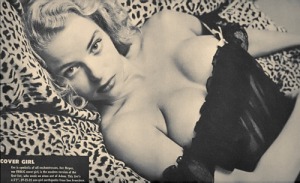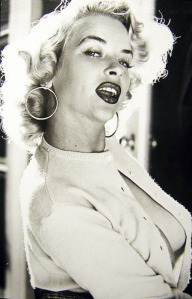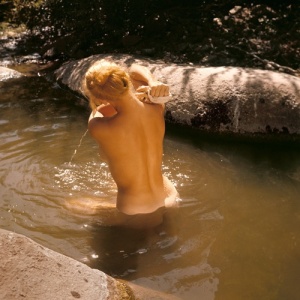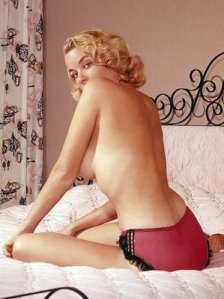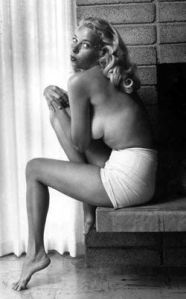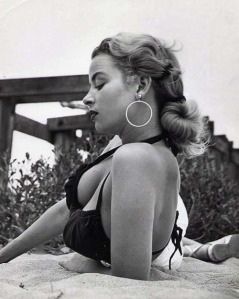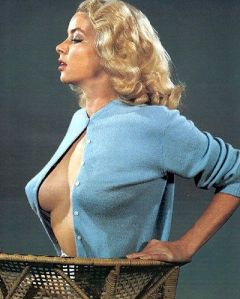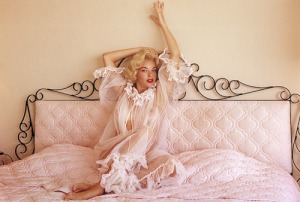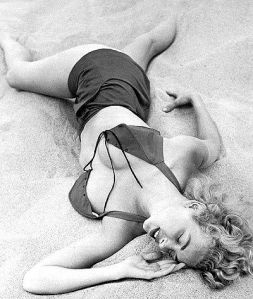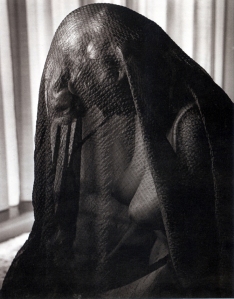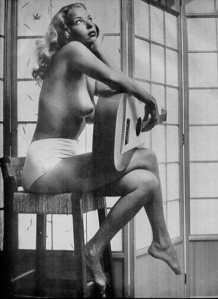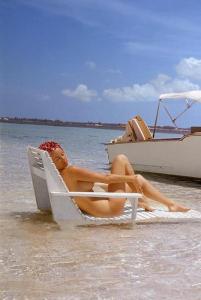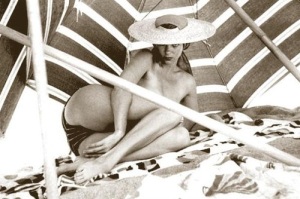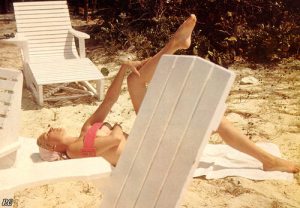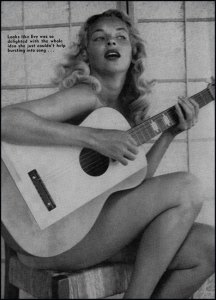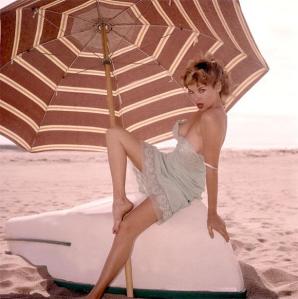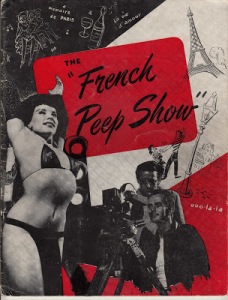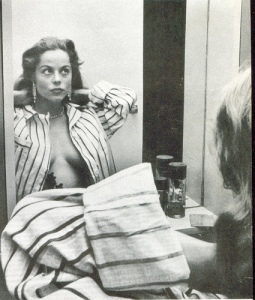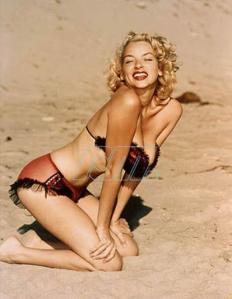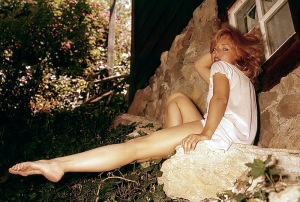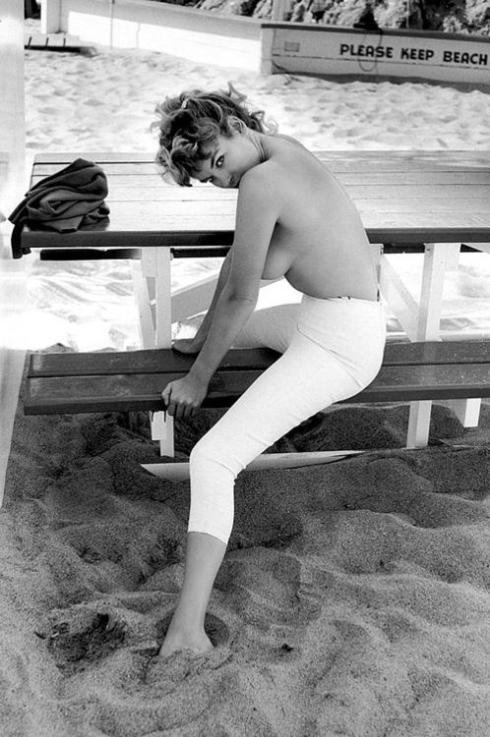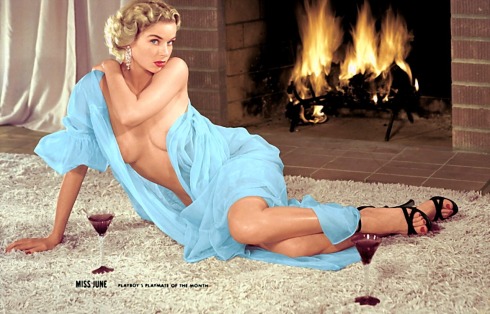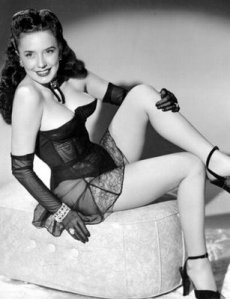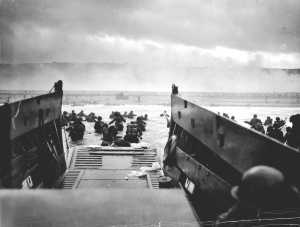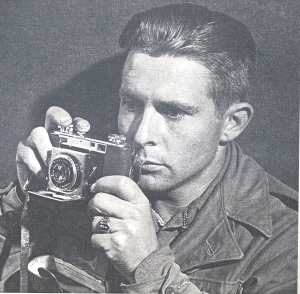There is no denying that Russ Meyer and his second wife Eve made a terrific team. Both knew how to work with each other, both understood their market and both always got the results they wanted. It was their first partnership however that would prove to be the most electric. Eve was a beautiful 50s pin-up, Meyer a talented cheesecake photographer. His pictures of her are the ones that stand out the most amongst his photographic career. It didn’t matter what angle Eve was in, what position, what lighting hit her, in each still Mr. Meyer took, nothing had ever looked more breathtaking. That isn’t to say that Eve was the only model Russ photographed, he continued to snap various models right up until he death, but none of these pictures have the charm, beauty or vitality that the ones of his wife produced. The following photographs are as accurately attributed to Russ Meyer as I could make them but verification in both books and on the internet is tricky. Some of these Russ took and some of these were probably taken by someone else but you get the idea. They just don’t make women like this anymore…
MEYER MONTH – ‘French Peep Show’ (1952)
1 MarThe time; the early 1950s. The scene; the El Rey Burlesk Theater in Oakland, California. The situation; photographer Russ Meyer makes something of a living photographing burlesque dancers and strippers in cheesecake poses on black and white film. Meyer’s favourite is stripper Tempest Storm and one day he decides to shoot a two hundred foot roll of Kodachrome of the girl working her stuff after closing hours.
Meyer was playing with fire. Only Kodak itself could process the film stock and in those days, the subject matter would have alarm bells ringing. He might even have his film confiscated. But the director made sure that a pretty girl delivered it personally to the lab and gave the lab man a little something extra. Things would have been fine, had Meyer not handed in the roll in a tin that bore his employer’s sticker, Gene Walker Films (Meyer at this point was also working on industrial short films). One call from Kodak to Walker later and Meyer was read the riot whilst also, surprisingly, being given his reel of film back. Russ showed El Rey manager Pete DeCenzie the footage which made his eyes bulge. DeCenzie asked Meyer to shoot a filmed version of a typical El Rey show and so one night, Russ smuggled his bosses 16mm camera into the club and churned out French Peep Show. This would be the start of Meyer’s film career.
Attributed to around 1952 but frequently to 1954, French Peep Show clocked in at an hour-long. Produced by Pete DeCenzie, the film plays host to Meyer’s first ‘directed by’ and ‘photographed by’ credits. Your standard El Rey show, he picture featured eight dancers, including Tempest Storm, and a host of comedians performing their acts. To accompany the production, a publication was also put together featuring Meyer’s pin-up photography and on-set production stills. According to Jimmy McDonough, Meyer told Fling magazine’s Arv Miller that the picture never got beyond pasties, which as McDonough notes would make some sense. It was the early 1950s and although nudity in film had been seen before, it’s hard to think that Meyer could have gotten away with showing topless burlesque dancers in the film. That said, I have no doubts that it was an exciting film none the less, a time capsule of entertainment that was once popular. If Meyer’s cheesecake photographs from this time are anything to go by, the picture would have been well executed, capturing well the routines of the strippers and dancers in all the seductive amusement.
Sadly, French Peep Show is no more. Out of circulation since its original theatrical run, it is now presumed lost. No one appears to have a copy, even Meyer himself didn’t hold on to one. According to him, once Pete died, his wife Yvonne burnt all remaining copies (Yvonne and Russ didn’t see eye to eye, especially when Russ wasn’t given his ten per cent of the profits that the picture saw). I remain optimistic that a remaining print still exists but doubt greatly that the Meyer estate hold a secret copy (otherwise it would have been a logical title to add to their recent release of Meyer’s early films that have never been publicly available before). Although The Immoral Mr.Teas was his first feature film and general success, I believe that had Meyer still had or had found a copy he would have released it whilst he was still alive. Always one to promote and publicise himself, even Russ would have understood French Peep Show’s significance for being the first example of all his cinematic career and style on celluloid (he openly admits that this is his first ‘proper’ film in a late 1990s interview for magazine Total Film) and as part of burlesque film history.
Mondo Vixens – Russ Meyer’s Glamour Photography
4 SepAnyone interested in Russ Meyer, or more specifically his glamour photography, needs to check out this site which will be posting photographs, pictorials and spreads only attributed to the man himself. If you’re a fan it’ll be well worth keeping an eye out to see images being slowly updated and if you have any of your own that you know were taken by Meyer, please get in touch!
The Marvelous Mrs. Meyer – Eve Turner (1928-1977)
9 AugBehind every successful man, there is a woman. Director Russ Meyer had three wives in his lifetime but it was his second wife, Eve Meyer (nee Turner), who really stands out from the crowd. Russ and Eve were a hardworking team, one that knew how to work with and bring out the best in each other. Even after they divorced, Eve remained a formidable force in his life. She was his original pin-up queen, the star of one of his films, the producer of countless others and a savvy business woman who knew how to deal with the sexploitation film market as much as her husband did. Eve Meyer, one of a kind.
Evelyn Eugene Turner was born into the world on December 13th 1928 in Atlanta, Georgia. After working a while for Western Union she was eventually transferred to San Francisco where she became a legal secretary for Pepsi. Turner always knew she could handle men and match them as an equal, being a great poker player and having a keen interest in fishing. She also has a vivacious sexual appetite, once even throwing Russ Meyer out of her house after a date when he (of all people!) suggested that they wait until their wedding night! A woman ahead of her time, her friend once said of her, ‘Eve was the first person that I ever saw wear pants and heels’.
As soon as Meyer set his eyes on Turner he knew she was the one for him. With a bust described as ‘conically maddening’ (a good thing for our breast loving director), Russ admitted that he knew he’d marry her the minute they’d met and he’d even go on to name his filmmaking company Eve Productions. She was the secretary of a lawyer, he was a divorce client of the said lawyer. He was given her number and the rest is history. After a tempestuous engagement, the two were married on August 2nd 1952 in San Francisco.
Eve was an incredibly beautiful woman and it wouldn’t take long for her to become a pin-up superstar in front of Russ’s camera. Her looks photographed well and her personality shone through in all her pictures; a woman that was able to be a girl-next-door one minute and a sultry vamp the next, Monroe crossed with Turner and then some. She already had some modelling experience behind her when she first met Russ, but it would take him months of persuasion to try to get her to pose for him. It’s not surprising that she eventually became one of the most popular pin-up models of the 1950s, constantly appearing in magazines like Adam, Fling, Modern Man and Frolic. Mr. Meyer even told stories that actress Ava Gardner had the hots for Eve (Mrs. Meyer accompanied her husband on one of his early jobs as a studio stills photographer and Gardner was his first assignment). In 1955, Eve appeared in Playboy as Miss June, in a fantastic spread photographed by her husband. The pictorial is electric and the gatefold in particular is more arousing then any porno picture I’ve seen that’s been shot in the last twenty years or so. The spread featured Eve by the fireplace, wearing a sheer gown that shows just about the right amount, with a look on her face that screams ‘Well, are you gonna come get it or not?’. I have always maintained that she was and is one of the most beautiful creatures to have ever graced this Earth, this spread being proof (a nice selection of some more gorgeous photographs from across her career can be found here).
Not content with being just a model, Eve also did some film work, predominantly working again for Russ in front of the camera. In 1954 or 1955 (dates vary according to sources) Eve starred in Russ’s first involvement within the exploitation movie business, an expose on abortion entitled The Desperate Women. Circling around innocent women and a shady backstreet abortionist (a clichéd character that Meyer revived for his studio picture Beyond the Valley of the Dolls in 1970), the posters showed an angst ridden Eve under the tagline ‘Shall I Take The ‘Easy’ Way Out?’. An uncredited role followed in 1955 as a model in Artists And Models and four years later Eve landed a lead role in war drama Operation Dames aka Girls In Action (1959). Difficult to find on home video format, the only video I’ve seen (posted below) shows that she is just as good in this as she was in her later picture with her husband, her natural good looks standing out and her enviable figure making more than an impression.
It would be Russ Meyer’s 1960 release Eve and The Handyman which saw Eve finally become her husband’s moving-image muse. Eve had been upset that Russ had ignored her whilst filming The Immoral Mr. Teas. Used to working as a team, Eve wasn’t the star in his first feature and was upset that some of the interiors were filmed inside the couples actual home. Russ made up for it by writing his second feature for his wife and, wow, does she shine in it. Using the scenes like Playboy photo shoot set-ups, Eve looks beautiful as she marches around in a trench coat and underwear following the Handyman, played by long-term Meyer friend Anthony James Ryan. By this point already used to Russ’s way of directing and shooting, Eve is one of the few women most comfortable in front of the directors camera throughout his entire filmography. The two could really work well together and it shows. He knows all the right angles to film her at and she knows just what the camera, and audience, are after. It’s just a shame that Handyman would be her last acting role. God knows where she would have gone had Meyer used her as an actress over and over.
It wasn’t just in front of the camera that Eve felt comfortable but behind it too. When Russ Meyer ran into trouble with Bill Teas over the distribution of sexploitation classic The Immoral Mr. Teas (the distribution of which Eve oversaw), it was his wife who came to the rescue, buying Teas out of his 2% share in the film. She also accompanied him to Europe in 1963 to help him shoot the footage that would comprise Europe In The Raw and eventually show up in a recycled form in Mondo Topless. She put up half of the bankroll for the production of Mudhoney. It’s no secret that she hated Faster, Pussycat! Kill! Kill! and had to be talked into co-financing it, only for it to bomb on release and drain Eve Productions dry. Eve even bailed out Russ during the production of Vixen! after he ran out of money, a bail out which saw very hefty returns in profit. Basically put, no Eve, no sexploitation/cult film classics from the 1960s. In total she produced fourteen of her husbands films, both his independent and studio releases. What do you expect from the girl who learnt to develop photographs so she could develop her husbands own pictures of her!
Once things started heating up for Russ in the mid-sixties, things in his marriage began to cool down. Eve reportedly didn’t like the direction his career was going in and was terrified of him getting involved with other women. Eve also began to drink, and by drink I mean really drink, which Russ detested. The two eventually divorced in 1968. An amicable separation (apparently even using the same attorney), the two still remained friends up until Eve’s tragic death in 1977. She was the distributer of all Russ’s films and produced a significant number of them after their divorce, including the studio pictures made under 20th Century Fox. Ever the savvy businesswoman, in 1970 she sold the entire catalogue of Meyer’s films to Optronics Laboratories for home video viewing. In 1971 she produced her only non-Meyer feature, The Jesus Trip, a drug/religion drama that involved motorbikes concealing heroin and a nun that doesn’t know whether she wants love or the Church. In 1975 there was a rumour that Eve was planning to write a book about her years collaborating with Russ that was to be titled This Doll Was Not X-Rated. Sadly the book never materialised but one wonders that it might have been full of juicy stories about the pair.
Eve Meyer died on March 27th 1977 in one of the deadliest aviation accidents in history. Arriving in the Canary Islands from Los Angeles for a holiday, Meyer’s plane was hit by another Boeing aircraft. Due to dense fog along the runway, neither plane nor Air Traffic Control could see that two planes were about to collide. In total, 583 people died with one plane being wiped out in its entirety. Despite their divorce, Russ was reportedly beside himself.
There is no doubting that Russ and Eve were meant for each other and loved one another very much. Not that their marriage was an easy one, with a fair few infidelities on Mr. Meyer’s part and a few alleged lesbian dalliances on Mrs. Meyer’s side. She also wanted children, whilst he was adamant that a family would only get in the way of his career. During the shoot for Lorna, Eve checked herself into a hospital for an unknown infection. Her words to Russ when he finally visited her were apparently ‘I can never have a baby, now. I hope you’re satisfied’. God knows how Eve would have felt if she found out that Russ actually had an illegitimate son with one of his starring ladies. No doubt their explosive marriage would have been far shorter. Differences aside, the two were a force to be reckoned with. Each knew the best in each other, what the audience wanted and how to deal with the business side of things. It’s hardly surprising that Russ Meyer’s most successful years were those with Eve at his side, whether it be as his muse, producer, wife or business partner. Whilst the world of sexploitation owes a lot to Russ, it seems that he couldn’t have done it without Eve.
Eve Meyer, one of a kind.
Maps – Russ Meyer’s ‘Europe In The Raw’ (1963)
2 MayRuss Meyer and sexploitation fans owe a lot to Arrow Films, the film distribution company known for putting out comprehensive DVD releases of cult and foreign films. Arrow have just re-released their Russ Meyer box set, well worth getting for two reasons. Firstly, these are the most detailed releases of Meyer’s back catalogue, complete with commentaries by the director and extras featuring his famous leading ladies. Secondly, the new re-release features Meyer’s 1963 picture Europe In The Raw, a film pretty much out of circulation since its initial theatrical run.
Filmed and released in 1963, Europe In The Raw was the first in Meyer’s ‘documentary’ trilogy (followed by Mondo Topless and Pandora Peaks, the latter more of a mockumentary…), shot as a reaction against what Meyer saw as anti US sentiment in the film Mondo Cane and the booming ‘mondo’ craze. His response was to go to Europe and shoot a sex shockumentary that showed up the continent as a sexually depraved, lust filled land. Shooting the footage himself and using both actual shots and faked scenes, Meyer had to limit himself to using cheap equipment and short film reels to pass off as a tourist and not a filmmaker to foreign officials. It shows. Whilst there are some fantastically framed compositions, the film isn’t as polished as his later efforts. All the hallmarks of his filmography are there but it feels significantly less accomplished in comparison to other features, especially Mondo Topless which successfully nailed the points that Meyer was trying to hammer when released three years later.
Travelling with wife and producer Eve Meyer, Russ managed to get some lovely shots of European burlesque dancers filmed on the cheap equipment, a lot of which later ended up being recycled into Mondo Topless. Certainly more teasing than tantalising, watching Europe In The Raw now is a slightly boring affair but it’s wonderful to see extended footage of dancers such as Veronique Gabriel, Gigi La Touche and Denise Duvall whose scenes appear in Mondo albeit slightly shorter and cut. Intercut amongst these performances are a few staged scenes which feel very out of place and stick out like a sort thumb; the faked nudist camp in Holland being the prime suspect. In an attempt to salvage the production, Russ hid a small camera in a bag with a cut out window and filmed reels of various red light districts across Europe. Needless to say, both he and Eve ran into a couple of bouts of trouble after a few prostitutes smelled a rat… After being chased out of one hookers apartment and failing to capture any noteworthy film, Meyer re-created walking up the flight of stairs to her room back in the comfort of the US with a well-stacked American model.
Completed with scenic images of Europe and footage shot by Meyer during the War, Europe In The Raw was withheld from public circulation as Meyer believed it wasn’t one of his best pieces of work. Honestly, I don’t blame him. It’s not his best but it certainly isn’t terrible and is in fact very interesting to watch to see the formations of his filmmaking techniques develop. The pompous narration is there, although not filled with as much innuendo as would later become staple. What is great is that Meyer’s career as a pin-up photographer is evident from the way the women are captured and framed. The dance routines of the burlesque performers play out like moving image Playboy pictorials, similar to the set-ups in Meyer’s first feature The Immoral Mr. Teas, with the editing fetishising their accessories and heightening the tease. It might not be Meyer’s best but for completest fans it’s a must.
MEYER MONTH – Russ Meyer, The Pin-Up Photographer.
16 MarMost of you will know Russ Meyer as the auteur of sleaze, the most successful and iconic filmmaker in the sexploitation genre. His films are love letters to hypersexual, highly empowered and incredibly curvaceous women. Meyer turned his breast fetish into a profitable career and, whether or not it floats your own boat (which becomes more debatable as his subjects get more exaggerated in his later films), he managed to capture on celluloid a bevy of lovelies in their unique beauty. One cannot deny that Meyer’s camera adored the women it was pointed at. Each of his shots were composed and lit with a knowledge and understanding of photographing the female form that many directors now struggle to achieve, even with good cinematographers behind them. Russ Meyer was so successful because of his extensive experience and career in photography which preceded his filmmaking. Not many people know that Meyer started out as a combat photographer during WWII before moving on to the world of glamour photography.
Evelyn ‘Treasure Chest’ West
Like many men returning from the War, Meyer found nothing but rejection when it came to finding work back home in America. After doing the rounds in Hollywood trying to find film work, Meyer eventually bought himself a Speed Graphic camera and set about photographing the women that he desired the most. The future director started out taking photographs of stripper Evelyn ‘Treasure Chest’ West, doing a deal with the Oakland night club she was appearing in which saw him supply them with free stills in exchange for time taking pictures of her. After continuing to photograph various strippers that came into town (developing his stills in the family bathtub, much to Mother Meyer’s delight), a fellow combat buddy of Meyer’s persuaded him to try to take advantage of the recent boom in girlie mags and become a pin-up photographer. Russ signed up with the Globe agency and found himself shooting pictorial’s for Gent, Fling, Frolic and Escapade amongst a number of other publications.
It was an encounter with one particular stripper that would kick-start the ambition in Meyer to become a filmmaker. Through photographing strippers, Russ met Tempest Storm who was performing at the El Rey Burlesk Theatre, owned by Pete DeCenzie. After doing some stills work which the two men would sell at the theatre, Meyer decided to shoot a short reel of film of Tempest doing her stuff. After smuggling the reel into Kodak to be developed, Meyer showed the it to DeCenzie who loved it and invited Russ to film a show at the El Rey. That reel of film became Meyer’s first short film, The French Peep Show (1950), which is now presumed lost.
Although bitten by the filmmaking bug, Meyer’s enthusiasm and talent for glamour photography never died. During the 1950s he shot numerous photographs of his second wife Eve Meyer, including her pictorial when she became June’s Playboy Playmate in 1955. Eve was probably the only woman to have lingered for any significant time in front of Meyer’s camera and his pictures of her are undeniably is best. All the women he shot look beautiful, well poised and immaculate. Eve just looks something else, stellar almost. The chemistry between her and Meyer is evident in every shot he took. It’s an understatement to say that they just don’t make women like that anymore. Alongside Eve’s Playboy gatefold, Meyer only shot another two; Marguerite Empey and Yvette Vickers.
Meyer would go on to shoot many famous models and actresses during the 50s establishing him as one of the prominent pin-up photographers of the decade. Throughout his life, Russ would snap away at his paramour’s, actresses and muses. Some would appear in publications like Playboy, for instance his pictorial of then-wife Edy Williams to publicise the never made Viva Foxy!, whilst others appear on every other page of his autobiography A Clean Breast like a catalogue of conquests. Clearly a huge influence on his filmmaking career, everything Meyer learnt about exposing and exhibiting the female form he learnt from his stills career and for those who haven’t seen much of it, it’s worth checking out. Trust me, you won’t be disappointed.
MEYER MONTH – Russ Meyer and WWII
7 MarMost people will know director Russ Meyer because of his somewhat sleazy career as a sexploitation filmmaker. But what many don’t realise is that Meyer learnt his craft photographing scenes of World War II during combat and spend the rest of his life very proud of what he had achieved during this experience, references of this time in his life scattered throughout his work and the strong bond he developed with some of his combat buddies lasting until the very end.
Meyer applied to be a volunteer combat photographer after seeing an advertisement placed in Popular Photography magazine by the Academy of Motion Picture Arts and Sciences. He became part of the Signal Corps Reserve and eventually in November 1944 was appointed staff sergeant with the 166th Signal Photographic Company, the official photo unit in General Patton’s Third Army during the Second World War. The 166th Signal Photographic Company went on to become one of the most decorated outfits in European operations, with Meyer receiving one of the fifty-five Bronze Stars it garnered amongst a vast number of other accolades. To say that Russ may have found his calling during the War would be an understatement. He was very good at what he did and this was recognised not only by his fellow photographers but by the Captains who would have to critique each photographers work as and when it was sent in. Meyer frequently got ‘very good’ in his reports on his work in both film and still photos. Combat footage that he shot was used in the Oscar-winning short Eisenhower: True Glory (1945) and the 1970 releases The Rise and Fall of the Third Reich and Patton. Footage that the Company shot can be viewed on this website but it doesn’t attribute it to any certain individuals.
Newsreel Unit 1. Meyer is in the middle row, third from the right. Charlies Sumners is top left.
Now it’s not uncommon knowledge that Meyer liked to embellish the stories he told, fabricating facts and, in some instances, stories in their entirety. One only needs to read his autobiography A Clean Breast to realise he contradicts himself at least once or twice. But there seems to be some element of truth in the fact that the original story for the novel and film The Dirty Dozen comes from an experience Meyer had during the War. Whilst in England, Meyer and fellow combat buddy Charlie Sumners were sent to a remote area to photograph the inhabitants of a prison stockade. All were heavily guarded, not allowed to talk, their legs bound in chains and once Meyer and Sumners had finished shooting footage it was promptly confiscated by the colonel in charge. Meyer recounted this tale to E. M. Nathanson in the 1950s who was interested and both tried to factually investigate what had happened but to no avail. In 1965, Nathanson had his novel based on the idea published which eventually became a film. Meyer ended up with ten per cent of Nathanson’s film deal, apparently calling the inmates ‘the Dirty Dozen’ in the first place. According to Sumners who was also there at the time, there were considerably more than a dozen of them.
Another interesting story that appears in Jimmy McDonagh’s biography of Meyer, Big Bosoms and Square Jaws, talks of an incident in which Meyer and Sumners were sent out to photograph a potential assassination attempt on Hitler and Goebbels. According to Sumners, this was another story fabricated by Meyer with no element of fact to it which is a real shame because what a story it was. Meyer would recall the time he was woken up in the middle of the night to go into a meeting headed by a Sixth Armored Division colonel and General Patton. Patton wanted Hitler and Goebbels assassinated and told Meyer he better be ‘damn careful about what he shot’. The following morning him and Sumners joined a team heading to Weimar where they found that Hitler and Goebbels had decided to return to Berlin instead and the mission was aborted. All, it would seem, a complete lie.
The Normandy Landing by Russ Meyer
World War II would also see Russ Meyer lose his virginity, largely thanks to Ernest Hemingway. One night Hemingway invited Meyer and a few of his buddies to the local whorehouse to have a night on him as he was friendly with the woman who ran it. It would seem that one girl there called Babette took a shine to Russ and gave him an experience that he never shut up about. Gloriously detailed and written in prose that a poet would blush at in A Clean Breast, Meyer illustrates the whole thing with a series of photographs showing a stiletto heel step on a cherry until it bursts. These ‘descriptive’ photographs aside, A Clean Breast also contains some terrific photos of a young Meyer in uniform and of his fellow Company men in action which are well worth a look at as it’s a whole side of the director that many people don’t know about. For us English there are also some beautiful shots of wartime Liverpool and Manchester which are great for historical value and some great sentimental shots of Meyer and his cohorts at the same places in the 1970s on one of their many reunion tours.
Meyer remained close friends with many of those he met during his time with the 166th Signal Photographic Company. Anthony James Ryan was a very close and faithful friend of Meyer’s until the very end, who ended up acting in, producing and writing some of Meyer’s films and almost became broke helping to finance some of the pictures. William ‘Bill’ Teas would wind up taking the lead in Meyer’s first feature-length effort The Immoral Mr. Teas, even lending his name to the now infamous titular character. Charlie Sumners and Meyer remained lifelong friends after their return to America, a picture of Sumners being the first image you see in Meyer’s ridiculously large autobiography. For all the reports of Meyer treating some of his friends badly, it would seem that he treated his fellow 166th buddies like the brothers he never had, organising reunions and dinners and even paying for some of them to attend when they didn’t have the funds themselves. It’s certainly a generosity that Meyer extended to very few people.
Charles ‘Charlie’ Sumners
During the 1960s, Meyer would express that he was ‘a rabid anti-communist’, probably in part due to the patriotism he developed during the War. This, and his distaste for the Nazi’s, would eventually run through his later work, with his 1968 picture Vixen! being a thinly disguised attack against communism which see’s the ‘all-American’ Vixen rise up against it and save the day (if you really want to believe that’s what the film is actually about under all the sex…). Meyer would frequently refer to Nazi’s in his work which some people have also put down to the fact that his absent father also happened to be German. ‘Martin Bormann’ pops up in Beneath the Valley of the Ultra-Vixens (1979) and in full Nazi regalia in earlier flick Beyond the Valley of the Dolls (1970) which see’s him get murdered in an assassination that I have no doubt Meyer wished actually happened during the War. Supervixens (1975) employs German marching music, Nazi references and a Martin Bormann character again. 1976 release Up! centres around the mysterious death of former Nazi Adolf Schwartz who is so obviously based on Hitler it doesn’t need further explanation. Whilst not about World War II specifically, Russ Meyer was one of the first directors to explore the idea of Post Traumatic Stress Disorder in veterans, using Motorpsycho (1965) to depict a disturbed Vietnam vet.
Russ Meyer’s experiences during the war certainly contributed to his visual style, filmmaking technique and military-esque production schedules that ran like clockwork. Like other film producers, directors and photographers, it’s nice to read that Meyer acknowledged that this was where it all started for him. The skills that he learnt and the passion that he developed for filmmaking only increased and developed upon his return to the States once the War had finished. Who knows what Meyer would have gotten up to had he not decided to reply to that ad he saw all those years ago…

